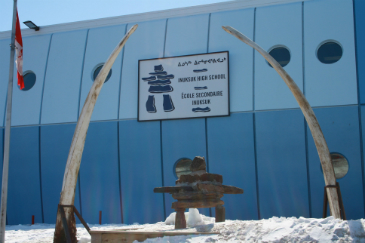One of the challenges in northern communities is keeping youth in school. Nunavut, Canada’s most northern and largest territory, has the country’s highest high school dropout rate. From 2001/2 to 2013/14, the average attendance rate in Nunavut high schools was only 60%, and over the same period, only approximately one-third of 18-year-old youth graduated from high school*. To understand these concerning statistics from an economic and social point of view, UWinnipeg economists Dr. Melanie O’Gorman and Dr. Manish Pandey decided to head north to help identify factors, with the hope of mitigating the situation.
First they analyzed whether completing a high school diploma ‘pays off’ in Nunavut – whether high school graduates earn more than their non-graduate counterparts. They found that indeed they do – high school graduates in Nunavut earned 95% more than non-graduates in 2000, and 82% more than non-graduates in 2005.
Their report then summarizes the results of a survey conducted of 570 youth from five Nunavut communities (Hall Beach, Igloolik, Iqaluit, Kugluktuk and Rankin Inlet), which consisted of questions regarding friends, home life, parents/guardians, school experiences and views on schooling.
What they found was a wide range of factors that influence early dropout. However, the most important factor was receiving encouragement from those close to them to stay in school. Their analysis of a sample of youth in school reveals that a student whose parents encourage them to go to school every day is 27% less likely to miss any days of school, and 26% less likely to ever think of dropping out of school. Analysis of an out-of-school sample indicates that a youth is 28% more likely to have missed days of school and 18% more likely to have actually dropped out of high school if they had friends who dropped out of school.
“While a number of factors affect high school attendance and dropout, two quantitatively important factors are a youth’s relationship with their parents and friends. In particular, parental inputs were found to be the most important for a youth’s attitude toward high school and attendance,” explained Pandey.
A youth who spent time on the land while they were in high school is 13% less likely to have dropped out of high school. O’Gorman and Pandey note that this likely reflects the value of closeness to one’s culture, which is in turn critical to identity formation and academic success.
With regard to their home life, the study finds that a child that has sufficient food to eat, a bed of their own and a quiet place to study is 13% more likely to graduate and 13% less likely to miss days of school. This transforms initiatives such as Nutrition North Canada and its needed reform into education policy. Many initiatives could improve food security in the territory, such as increased support for harvesters providing country foods or stable funding for breakfast programs in schools. The report also underscores the need for increased Federal funding for social housing in Nunavut, to address the long list of families waiting for affordable housing.
“Our findings suggest that diverse interventions are needed, ranging from greater instructional support for struggling students and more computers in the classroom, to a review of the daycare subsidy to ensure young parents can complete school,” explained O’Gorman. “These efforts call for action not just by many departments within the Government of Nunavut and DEAs, but also the Government of Canada and parents of school-aged Nunavut children”.







